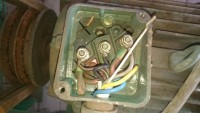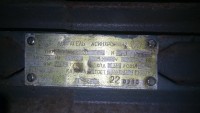Hello.
I have a problem with connecting a 3 phase motor. The nameplate says star connection. There are only 4 contacts to connect (phase I know how) while the fourth contact is connected to the motor housing. The whole device is metal, moreover, a yellow-green cable connected to the structure. What should go under the 4th PE or N contact so that the differential works correctly?
In the attachments, the motor's contacts are grounded on the bottom right, and the motor's nameplate
I have a problem with connecting a 3 phase motor. The nameplate says star connection. There are only 4 contacts to connect (phase I know how) while the fourth contact is connected to the motor housing. The whole device is metal, moreover, a yellow-green cable connected to the structure. What should go under the 4th PE or N contact so that the differential works correctly?
In the attachments, the motor's contacts are grounded on the bottom right, and the motor's nameplate




